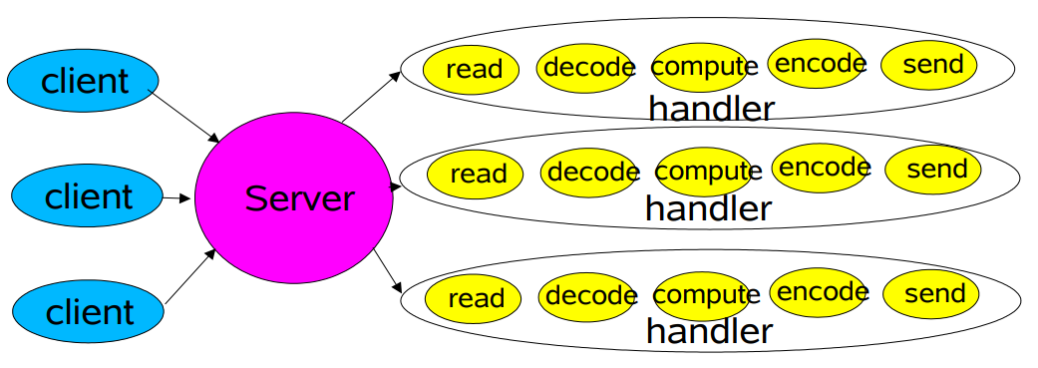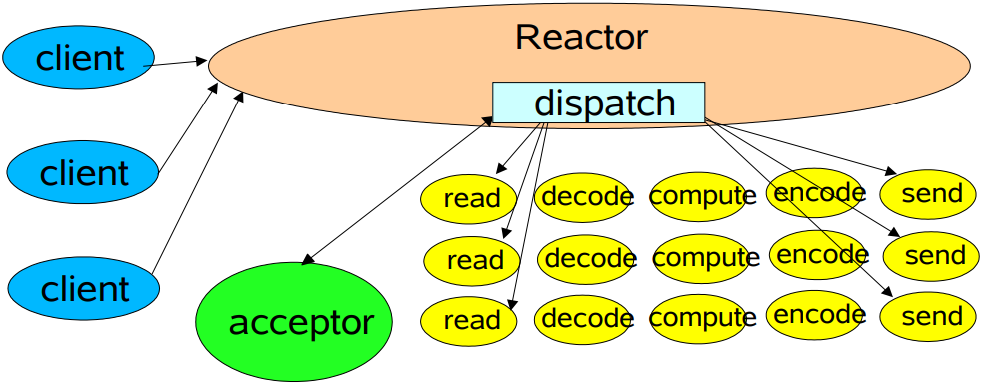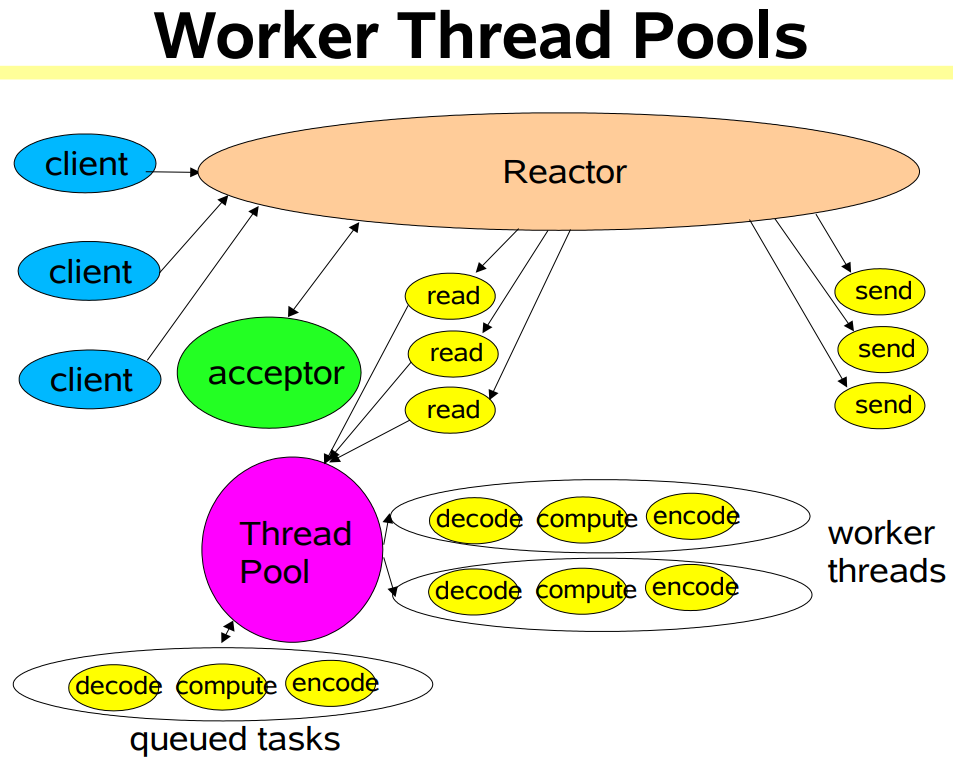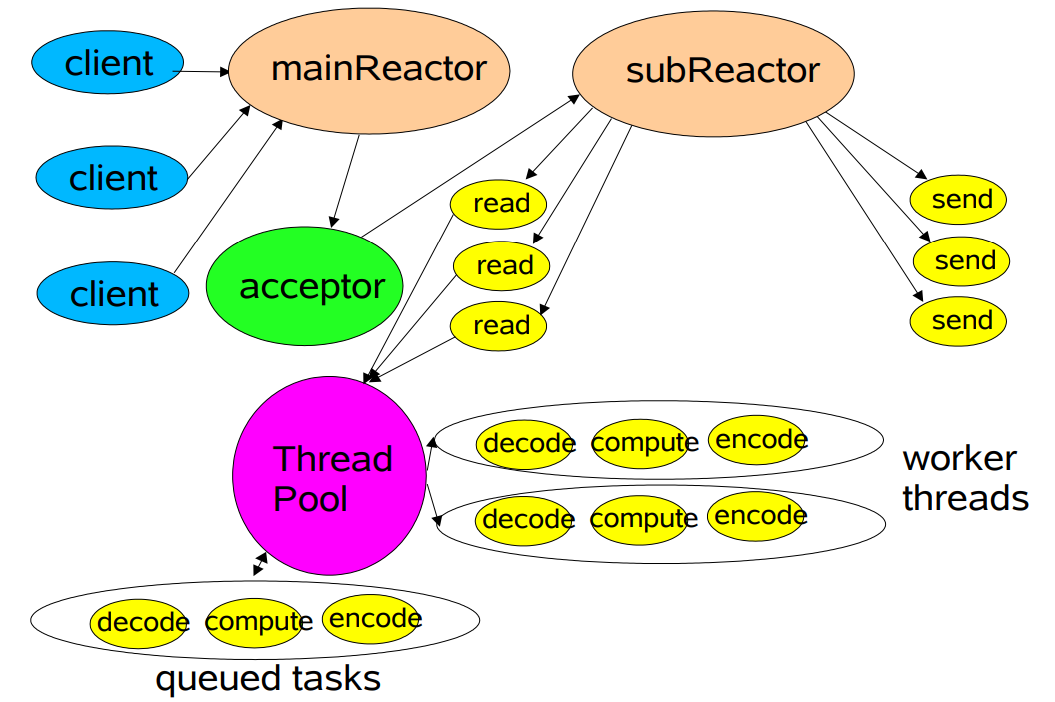concurrent包的大佬Doug Lea写的.介绍了下NIO的演进史?反正有助于学习NIO.
为了加深印象,挑了一些自己翻读一遍. 然而我翻了半天很多都没有道词典优雅,结果许多翻译都直接用有道词典...

Scalable network services
Classic Service Design
经典服务设计

Each handler may be started in its own thread
每个处理器(handler)可能会启动一个独占的线程.
Classic ServerSocket Loop
经典ServerSocket循环
class Server implements Runnable {
public void run() {
try {
//启动监听端口
ServerSocket ss = new ServerSocket(PORT);
//死循环直至线程中止
while (!Thread.interrupted())
//每当Server监听收到一个连接请求,启动一个线程处理连接. accept()为阻塞方法.
new Thread(new Handler(ss.accept())).start();
// or, single-threaded, or a thread pool
} catch (IOException ex) { /* ... */ }
}
static class Handler implements Runnable {
final Socket socket;
Handler(Socket s) {
socket = s;
}
public void run() {
try {
byte[] input = new byte[MAX_INPUT];
//读数据(阻塞)
socket.getInputStream().read(input);
byte[] output = process(input);
//写数据(阻塞)
socket.getOutputStream().write(output);
} catch (IOException ex) { /* ... */ }
}
private byte[] process(byte[] cmd) { /* ... */ }
}
}
Scalability Goals
实现弹性要完成的目标
Graceful degradation under increasing load (more clients)
Continuous improvement with increasing resources (CPU, memory, disk, bandwidth)
Also meet availability and performance goals
- Short latencies
- Meeting peak demand
- Tunable quality of service
Divide-and-conquer is usually the best approach for achieving any scalability goal
-
在负载增加(更多客户端接入)的情况下,可以很好的降级.
这里应该指响应上的降级而不是像以前一样暴死 -
能随着资源(cpu,内存,磁盘,带宽)的增加提升.
可能指性能上提升 -
同时满足可用性和性能目标.
- 低延迟
- 满足高峰需求
- 服务质量可调节
-
分治法一直都是满足任何弹性目标最好的实现
Divide and Conquer
分而治之
- Divide processing into small tasks Each task performs an action without blocking
- Execute each task when it is enabled Here, an IO event usually serves as trigger
Basic mechanisms supported in java.nio
- Non-blocking reads and writes
- Dispatch tasks associated with sensed IO events
Endless variation possible
- A family of event-driven designs
-
把处理过程分成小任务,每个任务执行一个没有阻塞的操作.
比如常见的{read request,decode request,process service,encode reply,send reply} -
当任务可用时执行,如图就是个将IO事件作为触发器的例子.
-
java.nio中支持的基础机制
- 非阻塞读写
- 任务事件的分发与IO事件的感知产生联系
这里应该具体指selector了,感知IO事件然后我们可以分发处理各事件.
-
可能是不断变化的.
永远不变的是变化- 一系列事件驱动的设计
Event-driven Designs
事件驱动 设计
Usually more efficient than alternatives
Fewer resources : Don't usually need a thread per client.
- Less overhead : Less context switching, often less locking.
- But dispatching can be slower : Must manually bind actions to events
Usually harder to program
Must break up into simple non-blocking actions
- Similar to GUI event-driven actions
- Cannot eliminate all blocking: GC, page faults, etc
Must keep track of logical state of service
-
通常比其他选择更有效率
- 更少的资源占用 : 不用总是一个client一个线程.
- 更少的开销 : 减少了上下文切换,更少的锁.
- 但是任务调度可能会更慢 : 必须手动绑定事件的行为.
-
通常编码更困难
-
必须拆解成简单的非阻塞行为.
- 类似于GUI事件驱动操作
- 无法消除所有阻塞 : GC , 磁盘page错误 等等
-
必须跟踪服务的逻辑状态.
这段没理解
-
Reactor Pattern
reactor模式
Reactor responds to IO events by dispatching the appropriate handler
- Similar to AWT thread
Handlers perform non-blocking actions
- Similar to AWT ActionListeners
Manage by binding handlers to events
- Similar to AWT addActionListener
-
Reactor 负责响应IO事件并将其分发到适当的handler上.
- 类似于AWT线程
-
Handlers 负责执行非阻塞操作
- 类似于AWT操作监听器
-
通过将handlers绑定到事件上进行管理
- 类似于AWT的添加操作监听器接口
java.nio Support
ChannelsConnections to files, sockets etc that support non-blocking reads
BuffersArray-like objects that can be directly read or written by Channels
SelectorsTell which of a set of Channels have IO events
SelectionKeysMaintain IO event status and bindings
-
Channels连接到文件,sockets等,支持费阻塞读
-
Buffers类似数组的对象,可由通道直接读取或写入
-
Selectors告诉哪一组通道有IO事件
-
SelectionKeys维护IO事件状态和绑定信息
Basic Reactor Design
Single threaded version
单线程版本

public class BasicReactorDesign {
final Selector selector;
final ServerSocketChannel serverSocket;
/**
* Reactor : Setup
*
* @param port 端口号
* @throws IOException IO异常
*/
BasicReactorDesign(int port) throws IOException {
//reactor启动,打开selector
selector = Selector.open();
//打开ServerSocket监听端口
serverSocket = ServerSocketChannel.open();
serverSocket.socket().bind(new InetSocketAddress(port));
//设置为非阻塞模式
serverSocket.configureBlocking(false);
//selectionKey
SelectionKey sk = serverSocket.register(selector, SelectionKey.OP_ACCEPT);
sk.attach(new Acceptor());
}
/*
Alternatively, use explicit SPI provider:
SelectorProvider p = SelectorProvider.provider();
selector = p.openSelector();
serverSocket = p.openServerSocketChannel();
*/
/**
* Reactor : Dispatch Loop
*/
public void run() { // normally in a new Thread
try {
while (!Thread.interrupted()) {
selector.select();
Set<SelectionKey> selected = selector.selectedKeys();
for (SelectionKey selectionKey : selected) {
dispatch(selectionKey);
}
selected.clear();
}
} catch (IOException ex) { /* ... */ }
}
void dispatch(SelectionKey k) {
Runnable r = (Runnable) (k.attachment());
if (r != null) {
r.run();
}
}
/**
* Reactor : Acceptor
*/
class Acceptor implements Runnable { // inner
@Override
public void run() {
try {
SocketChannel c = serverSocket.accept();
if (c != null) {
new Handler(selector, c);
}
} catch (IOException ex) { /* ... */ }
}
}
/**
* Reactor : Handler setup
*/
final class Handler implements Runnable {
public static final int MAXIN = 1024;
public static final int MAXOUT = 1024;
final SocketChannel socket;
final SelectionKey sk;
ByteBuffer input = ByteBuffer.allocate(MAXIN);
ByteBuffer output = ByteBuffer.allocate(MAXOUT);
static final int READING = 0, SENDING = 1;
int state = READING;
Handler(Selector sel, SocketChannel c) throws IOException {
socket = c;
c.configureBlocking(false);
// Optionally try first read now
sk = socket.register(sel, 0);
sk.attach(this);
sk.interestOps(SelectionKey.OP_READ);
sel.wakeup();
}
boolean inputIsComplete() {/* ... */}
boolean outputIsComplete() {/* ... */}
void process() {/* ... */}
//Reactor 5: Request handling
@Override
public void run() {
try {
if (state == READING) {
read();
} else if (state == SENDING) {
send();
}
} catch (IOException ex) { /* ... */ }
}
void read() throws IOException {
socket.read(input);
if (inputIsComplete()) {
process();
state = SENDING;
// Normally also do first write now
sk.interestOps(SelectionKey.OP_WRITE);
}
}
void send() throws IOException {
socket.write(output);
if (outputIsComplete()) {
sk.cancel();
}
}
}
}
Multithreaded Designs
多线程设计
Strategically add threads for scalability
- Mainly applicable to multiprocessors
Worker Threads
Reactors should quickly trigger handlers
- Handler processing slows down Reactor
Offload non-IO processing to other threads
Multiple Reactor Threads
Reactor threads can saturate doing IO
Distribute load to other reactors
- Load-balance to match CPU and IO rates
-
有策略地添加线程以实现可伸缩性
- 主要适用于多处理器(多核)
-
工作者线程组
-
rector线程组应该可以快速触发handler线程组.
- handler线程组根据处理能力可以降级reactor.
我的理解
- handler线程组根据处理能力可以降级reactor.
-
将非IO处理操作转移至其他线程组
-
-
复数reactor线程
-
reactor线程组能做IO操作至饱和
-
将负载分摊给其他reactor.
不知是否如此翻译- 负载均衡CPU与IO的比率
-
Worker Threads
worker线程组
Offload non-IO processing to speed up reactor thread
- Similar to POSA2 Proactor designs
Simpler than reworking compute-bound processing into event-driven form
Should still be pure nonblocking computation
- Enough processing to outweigh overhead
But harder to overlap processing with IO
- Best when can first read all input into a buffer
Use thread pool so can tune and control
- Normally need many fewer threads than clients
-
卸下非IO处理来提速reactor线程
- 类似于POSA2的Proactor设计
-
比无界计算处理重构成事件驱动形式更简单
-
应该仍然是纯粹的非阻塞计算
- 足够的处理能力比因此引入的开销更有价值
-
-
但难与IO重叠处理
- 最好在第一次读取所有输入到缓冲区
-
使用线程池,这样可以调优和控制
- 通常需要的线程比客户机少得多
Worker Thread Pools

Handler with Thread Pool
可拿此handler带入原basic design版本.直接变成上图形式.
class Handler implements Runnable {
// uses util.concurrent thread pool
static PooledExecutor pool = new PooledExecutor(...);
static final int PROCESSING = 3;
// ...
synchronized void read() { // ...
socket.read(input);
if (inputIsComplete()) {
state = PROCESSING;
pool.execute(new Processer());
}
}
synchronized void processAndHandOff() {
process();
state = SENDING; // or rebind attachment
sk.interest(SelectionKey.OP_WRITE);
}
class Processer implements Runnable {
public void run() { processAndHandOff(); }
}
}
Coordinating Tasks
协调任务?
Handoffs
- Each task enables, triggers, or calls next one Usually fastest but can be brittle
Callbacks to per-handler dispatcher
- Sets state, attachment, etc
- A variant of GoF Mediator pattern
Queues
- For example, passing buffers across stages
Futures
- When each task produces a result
- Coordination layered on top of join or wait/notify
-
Handoffs
咋翻译?- 每个任务启用、触发或调用下一个任务.
- 通常是最快的,但也可能很脆弱
-
对每个per-handler dispatch都有回调
- 设置状态,附件等
- GoF Mediator模式的一种变体
-
队列
- 举个例子: 将缓冲区buffer传递过各个阶段.
-
Futures
- 当每个任务产生一个结果
- 协调层在join或wait/notify的顶部
Using PooledExecutor
使用线程池. 从这篇文章看来,这部分是介绍线程池的使用?
A tunable worker thread pool
Main method execute(Runnable r)
Controls for:
The kind of task queue (any Channel)
Maximum number of threads
Minimum number of threads
"Warm" versus on-demand threads
Keep-alive interval until idle threads die
- to be later replaced by new ones if necessary
Saturation policy
block, drop, producer-runs, etc
-
一个可调节工作线程池
-
主要方法为execute(Runnable r)
-
(需要?)控制:-
任务队列的类型(任何Channel)
-
最大线程数
-
最小线程数
-
"预热"以应对随机应变的线程
-
保持活动时间间隔,直到空闲线程死亡
- 如有必要,以后再用新的代替
-
饱和策略
- 阻塞,抛弃,producer-runs
(这东西怎么翻译?)等.
- 阻塞,抛弃,producer-runs
-
Multiple Reactor Threads
多Reactor线程
Using Reactor Pools
Use to match CPU and IO rates
Static or dynamic construction
- Each with own Selector, Thread, dispatch loop
Main acceptor distributes to other reactors
-
使用reactor池
-
用于匹配CPU和IO速率(这个IO rates不知道怎么翻译?)
-
静态或动态构造器(还是该翻译成结构呢?)
- 每个(应该指每个reactor线程)都有自己的selector,线程,调度loop(调度组件.)
-
主接收器(指负责accept的reactor吧)分发给其他reactor
-
Selector[] selectors; // also create threads
int next = 0;
class Acceptor { // ...
public synchronized void run() { ...
Socket connection = serverSocket.accept();
if (connection != null)
new Handler(selectors[next], connection);
if (++next == selectors.length) next = 0;
}
}
Using Multiple Reactors

Using other java.nio features
使用其他java.nio特性
Multiple Selectors per Reactor
- To bind different handlers to different IO events
- May need careful synchronization to coordinate
File transfer
- Automated file-to-net or net-to-file copying
Memory-mapped files
- Access files via buffers
Direct buffers
- Can sometimes achieve zero-copy transfer
- But have setup and finalization overhead
- Best for applications with long-lived connections
-
每个reactor有多个selector
- 将不同的处理程序绑定到不同的IO事件
- 可能需要小心地使用同步来协调
-
文件转换
- 自动[文件到网络]或[网络到文件]的复制
-
内存映射文件
- 通过缓冲区访问文件
-
直接缓冲区
- 是否可以实现零拷贝
- 但是有初始化和销毁的开销
- 最适合具有长期连接的应用程序
Connection-Based Extensions
基于连接的扩展
这部分并不是很明白在讲啥.可能在讲更多的扩展模型
Instead of a single service request
- Client connects
- Client sends a series of messages/requests
- Client disconnects
Examples
- Databases and Transaction monitors
- Multi-participant games, chat, etc
Can extend basic network service patterns
- Handle many relatively long-lived clients
- Track client and session state (including drops)
- Distribute services across multiple hosts
-
并不是单个服务请求
- 客户端连接
- 客户端发送一系列的消息/请求
- 客户端断开连接
-
样例
- 数据库和事务监视器
- 多人游戏、聊天等
-
可以扩展基本的网络服务模式
- 处理许多寿命相对较长的客户机
- 跟踪客户端和会话状态(包括丢弃)
- 跨多个主机分发服务
